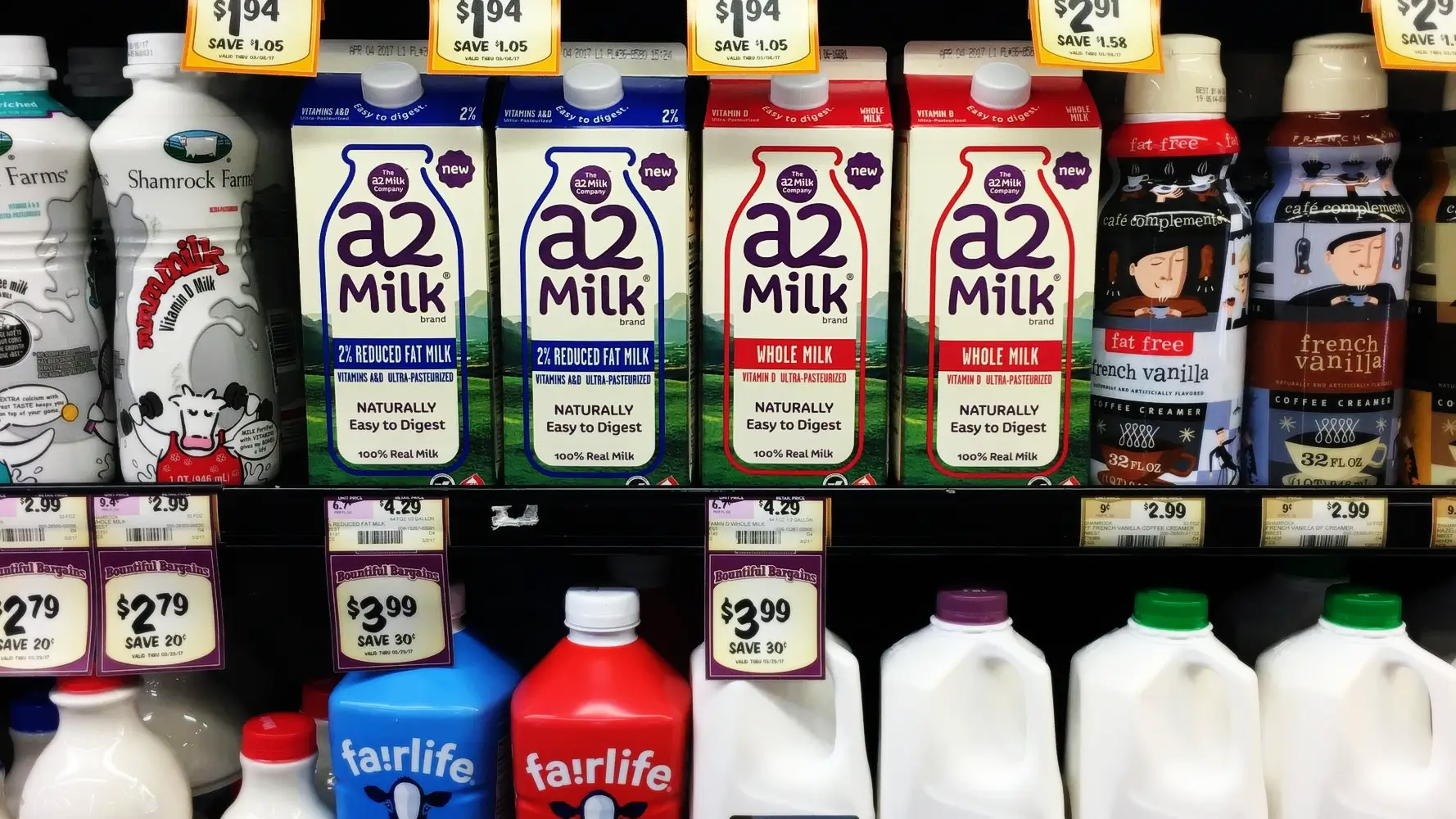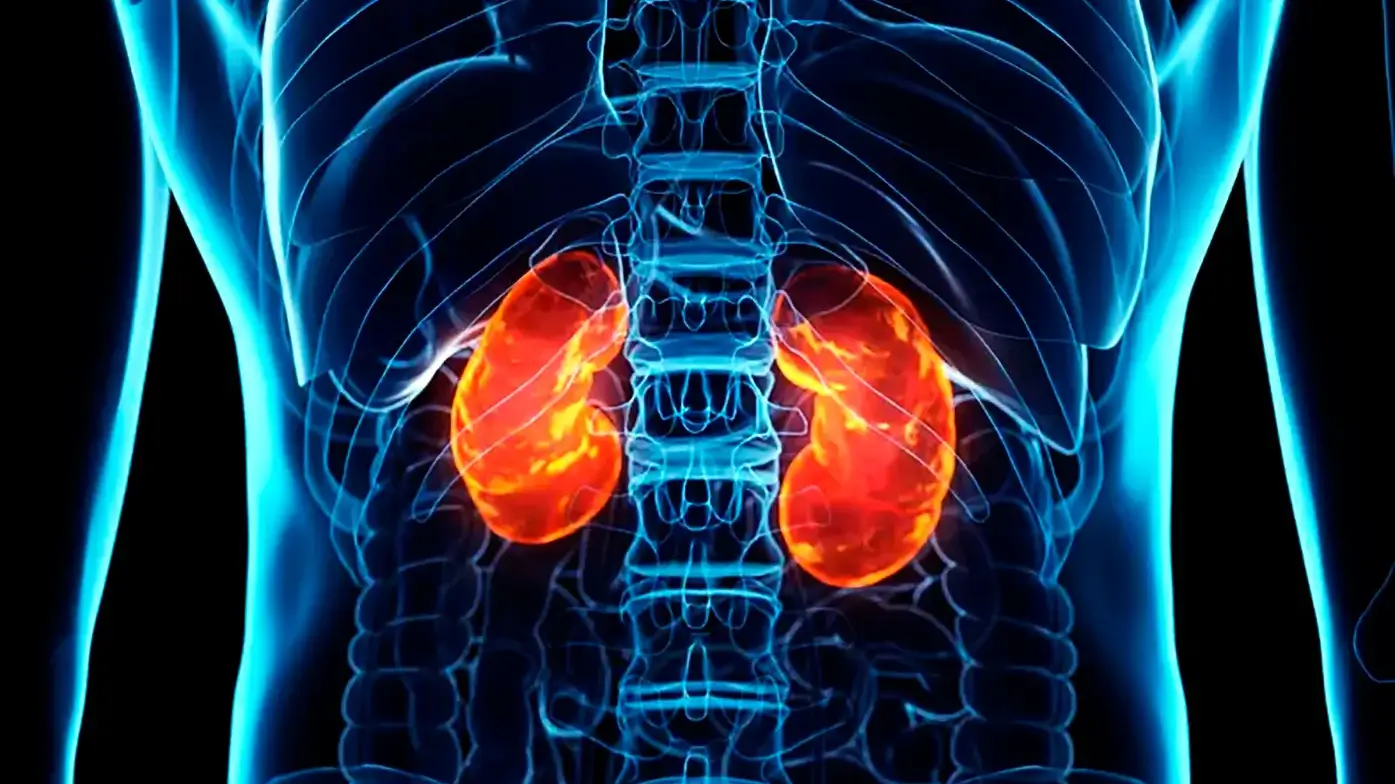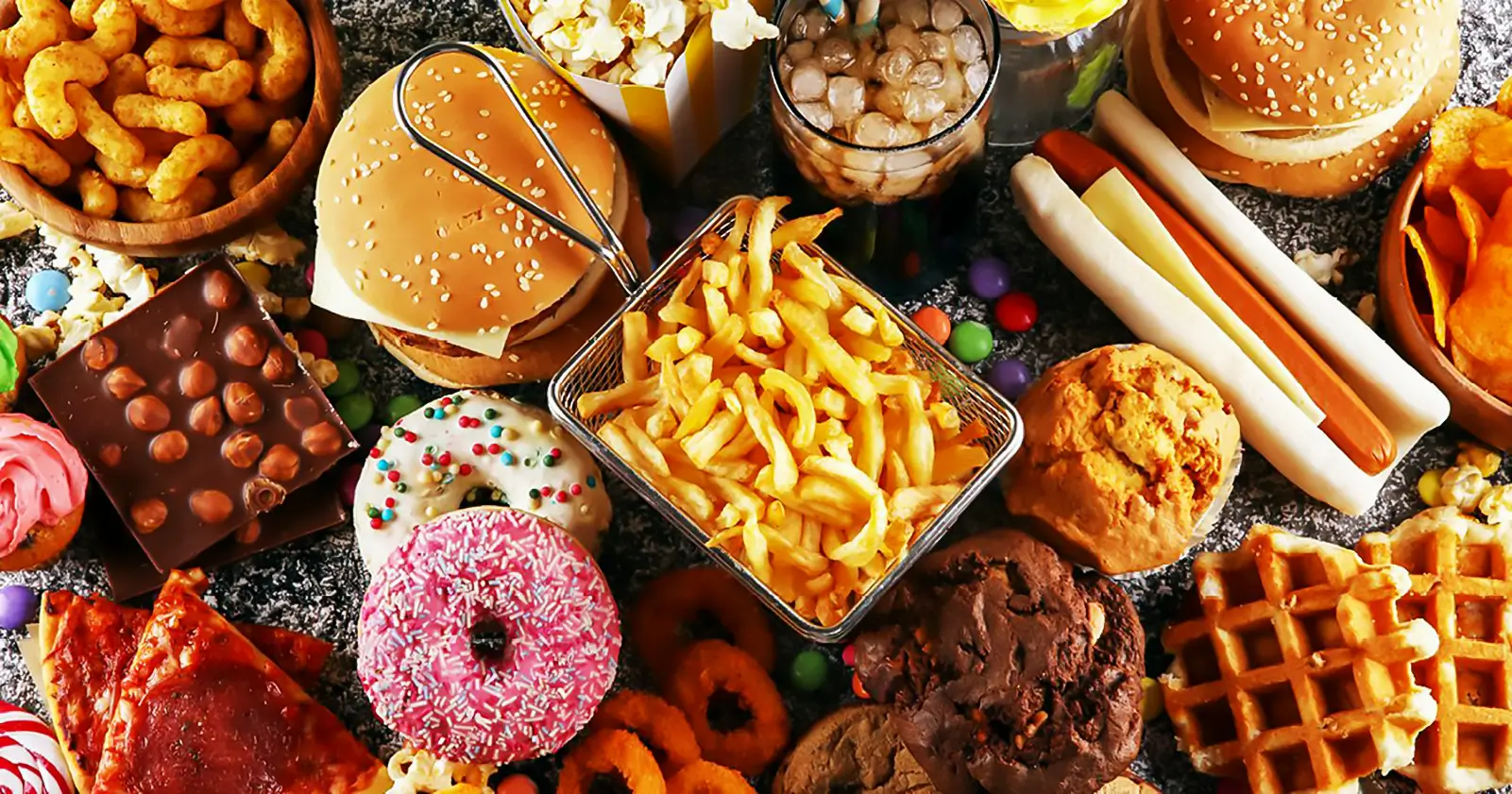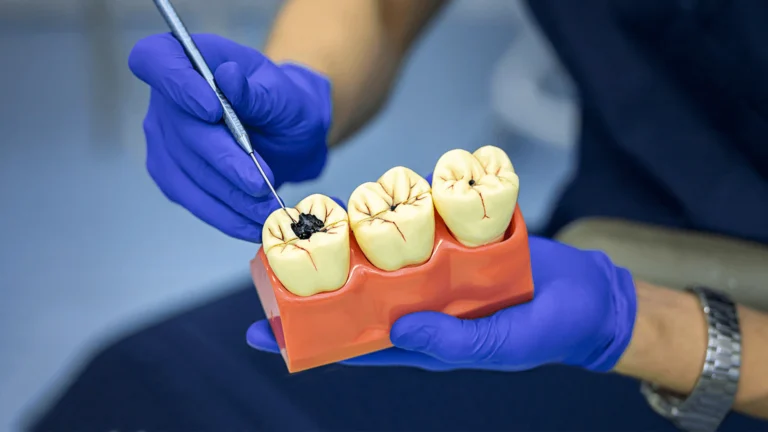Milk and Dairy: Health Risk Correlations
Known associations with milk and dairy consumption are infertility, ovarian and breast cancer, leukemia, diabetes type 1, autism, arteriosclerosis, cataract, rheumatoid arthritis, multiple sclerosis, hyperactivity, congestion, pimples, and more…
Milos Pokimica
Written By: Milos Pokimica
Medically Reviewed by: Dr. Xiùying Wáng, M.D.
Updated June 10, 2023Key Takeaways:
– Infants fed with any other milk than their mother’s milk have lower IQs at an average level.
– The established relationship of the link between A1 beta-casein and type 1 diabetes, and heart disease is 0.982 and 0.76.
– Humans cannot digest the casein properly.
– Everyone, every human on the planet Earth if it is a grown individual has galactosidase deficiency.
– Elderly cataracts come from galactose.
– Women are accumulating galactose around the ovaries, and it is associated with cancer of the ovaries and infertility.
– Even in small doses, galactose increases the changes that resemble natural aging.
– About 86% of the population in the U.S. have bovine leukemia virus antibodies detected.
– Pasteurization kills all of the bacteria but also some of the vital enzymes (catalase, peroxidase, phosphatase) and vitamins, reduces protein value (amino acid composition) by 17%, vitamin B complex is destroyed by 38%, and vitamin C is destroyed. Only 25% of the calcium in cow milk is absorbable by the body, which is due to lacking digestive enzymes in humans.
– The countries with the greatest milk consumption also have the biggest risk of osteoporosis.
– Bovine somatotropin or BGH was used since 1994 in the production of cattle meat and is associated with cancer (breast, prostate, and colon), and adds to another set of disorders such as premature puberty in children.
– Humans consume milk obtained from heifers in the latter half of pregnancy when the estrogen levels in cows are markedly elevated.
– Androgenic hormones from milk promote the development of acne vulgaris, and premature puberty and stimulate cancer growth.
– The 5alpha-pregnanedione (5alpha-P) is the main androgenic or sex hormone present in milk.
– Dairy is associated with lower sperm count and movement and direct testicular damage. It is as damaging to testis as cholesterol.
– Dairy products are second on the list of all food products that raise cholesterol and this is because of casein.
– BCM7 has a pro-oxidative impact on LDL.
– Autistic children and schizophrenia adults showed a constant elevated abnormal value of casomorphin and gluteomorphin opioid peptides obtained from beta-casein and gluten.
– Circulating BCM7 peptides in an infant’s developing central nervous system could impair their respiratory center leading to apnea and Sudden Infant Death Syndrome (SIDS).
– Cow milk consumption can weaken the immune function in children
Known health risk associations.
Health risks that are known to associate with dairy product use are chronic fatigue, headaches, hyperactivity (add, ADHD), brain damage and neurotoxicity, autism, allergy and congestion, asthma and respiratory problems, early arteriosclerosis from oxidized cholesterol, cardiac arterial disease, diabetes type 1, rheumatoid arthritis, multiple sclerosis, a decline of the intelligence, pimples, bedwetting, premature puberty, leukemia, cancer and especially breast cancer, ovarian cancer, cataract, osteoporosis, IGF 1 related diseases, obstipation, diarrhea. In cow’s milk are bacteria, viruses, prions, antibiotics, hormones, pesticides, and other toxins and heavy metals.
Business model.
The media and the world tell us that milk is essential, and that cannot be substituted. It is one of the vital food items, but let’s look at some interesting facts.
If you have one ordinary wild cow that lives in the plains in Africa, then such a cow will produce 3 liters of milk per day.
That is enough to nourish its calf, and of course, the calf is equipped to consume that milk. For the calf, there is no more natural food than that.
The protein in milk is called Casein.
It is a large globular protein not like the one found in vegetables. It needs a particular digestion mode to be absorbed correctly. Casein needs a particular enzyme called rennin so that the body can dissolve it into amino acids. Without this enzyme rennin, it cannot be utilized. It will pass the digestive system unabsorbed as a globular protein. The body absorbs only individual amino acids after the protein is broken down in the digestive tract. The calf will produce this enzyme in adequate amounts.
When we approach the business model of today’s economics that translates into “let’s make more money”, we will select cows for milking that are genetically conditioned to produce more milk in a day. Much more milk than wild cows. A good cow will produce 20 liters of milk per day, and a very good cow will produce 40 liters of milk per day, an excellent cow will produce 80 liters. The World Champion has produced over 120 liters a day.
Casein.
We have to have milk in our diet, as the story goes, because of the fact that milk is one of the main sources of calcium and protein in the standard American diet. Then about fat and lactose and other bad things in it, the media do not speak much. They say that we consume our daily dose of calcium and a big chunk of protein primarily from milk. It is all about the calcium we need and proteins. We have been taught since the day we were babies to take the necessary doses of dairy products.
Human milk has the lowest concentration of proteins of all other mammal species.
Human milk has the lowest proportion of casein to whey of all other mammal species.
“Milk is for babies. When you grow up you have to drink beer”
– Arnold Schwarzenegger
Why does human milk have the lowest concentration of proteins among all mammals?
The casein from each species is uniquely suited to meet the metabolic needs of that species, which means that it will have a specific amino acid composition.
The amount of protein in milk is uniquely suited to meet the growing needs of that species.
It’s 10g / l in human milk, and it takes 120 days for an infant to double its weight after birth. Horses have 24g / l and it takes 60 days to double the weight. Cow milk has 33g / l and it takes only 47 days. Dogs have 71g / l with only 8 days. Rats 86.9 g /l and after 4.5 days baby rats are double in size. If protein is what we want the best source would be rat’s milk.

Now let’s think a little about this for a moment. If you are a rat, you need to grow rapidly to survive. If you are a rat, you need all that protein, and that is normal. However, why would grown-up humans need all of that protein from milk? So that we can get cancer and shorten our life from excessive IGF 1 and have diabetes and heart attack from all of that saturated fat.
When there is a doubling of the weight of the calf in 47 days that is because of evolutionary reasons for survival. The calf needs to strengthen fast, and it only takes a few hours to start walking. It has to do so because many predators are lurking around and it needs to be big and strong as soon as possible to survive. It grows rapidly because it has many natural predators, so the energy in calves goes into the development of muscles, and for the development of muscles, it has a high dose of protein in milk during growth. A human baby needs constant care and is helpless and is growing so slowly in relation to the calf. What is the crucial thing for a human baby, the rapid growth of muscles? How about the brain?
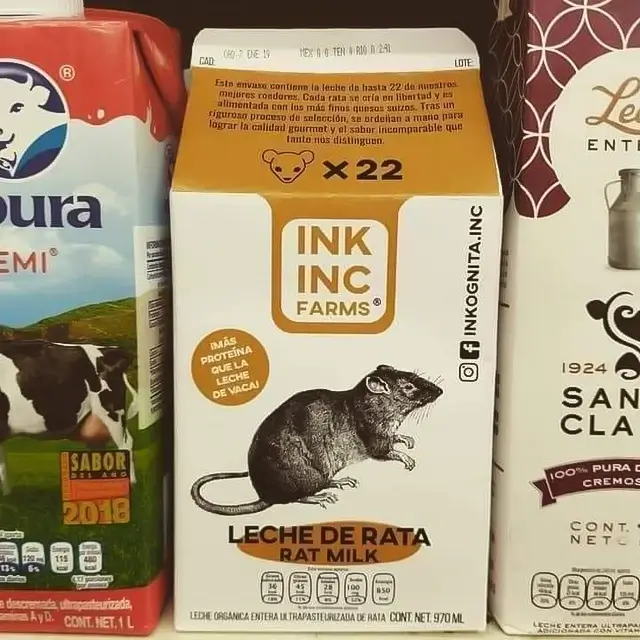
Infant’s brain development.
When the baby is born the head still has not closed fountains, and then the brain must develop very rapidly. Even the nerve endings are not entirely formed after birth, so the brain needs food to develop. One day a cow will not be interested in mathematics, but a human might. What kind of food is necessary for brain development? These are fats. Most of your brain tissue consists of fat. There is a much higher fat ratio in human milk in relation to a protein that is perfect for brain development. The cow has a perfect relationship for the development of muscles.
You can understand why children who are raised on cow’s milk instead of their mother’s milk might have lower intelligence coefficients.
There are studies done on this and not just one but hundreds of them. It is a well-documented fact in medicine that infants fed with any other milk than their mother’s milk have lower IQs at an average level.
Also feeding infants with cow’s milk leads to an 80% probability of getting diarrhea, and a 70% probability of an outbreak of ear infections compared to infants nourished with mother’s milk (Scariati et al., 1997). Babies fed with cow’s milk during the other six months of life have a 30% increase in blood loss and a significant loss of iron in their stool and low intakes of iron in general, linoleic acid, and vitamin E, and excessive intakes of sodium, potassium, and protein (“The Use of Whole Cow’s Milk in Infancy,” 1992b).
In this study (Kost et al., 2009) the babies fed on cow’s milk with a higher level of bovine casomorphins seem to suffer from psychomotor delay but exactly the reverse was found for human casomorphins. Human casomorphins seams to help the brain of humans. The conclusion of the study was:
“The highest basal irHCM (human casomorphins) was observed in breast-fed infants with normal psychomotor development and muscle tone. In contrast, elevated basal irBCM (cattle casomorphins) was found in formula-fed infants showing a delay in psychomotor development and heightened muscle tone. Among formula-fed infants with normal development, the rate of this parameter directly correlated to basal irBCM. The data indicate that breastfeeding has an advantage over artificial feeding for infants development during the first year of life and support the hypothesis for the deterioration of bovine casomorphin elimination as a risk factor for delay in psychomotor development and other diseases such as autism.”
(Kost et al., 2009)
The problem is in the protein. The composition of casein in human and cow milk varies greatly, with only a 47% similarity between the two. Moreover, if the mixture contains mutated A1 casein, it can potentially lead to the development of type 1 diabetes in infants.
The problem is casein. Cows have rennin, but babies have very little, so they do not tolerate that protein. In the mother’s milk, breast milk produces the bacterium Bacillus Bifidus, which helps to dissolve casein from human milk. Cow milk in the child causes acidity, and also in adults, and irritates the intestines so that the intestines start to bleed. In addition to this, even the magazine of the scientific dairy industry will say that milk raises the level of cholesterol. Milk fat is identified as fat because it contains cholesterol and is primarily saturated.
Milk is good for rising cholesterol levels, for the lack of iron that occurs due to bleeding in the digestive organs, and for diabetes (Scott, 1990).
There are well-known studies from Harvard, about ovarian cancer, I will cite the famous British Magazine Lancet (Cramer et al., 1989).
The one thing that milk is supposed to be good for is osteoporosis. In real life when correlations are studied dairy consumption results in the worsening of the symptoms. You can find more about the osteoporosis correlation in this article (High protein diet and metabolic acidosis).
Diabetes type 1.
Diabetes type 1 has long been known to correlate to milk consumption or more specifically cow’s milk and dairy. Not all milk.
The established relationship of this link between A1 beta-casein and type 1 diabetes, and heart disease is 0.982 and 0.76 (Laugesen and Elliott, 2003).
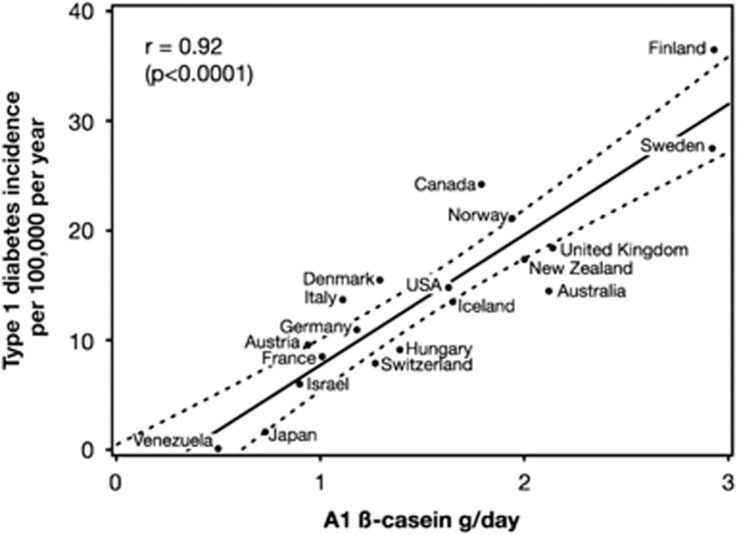
Today we know that even mothers who drink cow’s milk while their children breastfeed can cause the baby to develop type 1 diabetes. They have discovered that if a mother drinks milk, then partially digested casein can end up in the bloodstream and can end up in his mother’s milk too. Our bodies cannot get rid of that globular protein in the blood, so it gets thrown out everywhere including mother’s milk.
The famous medical journal Lancet published in 1999 that new evidence favors a controversial theory that feeding cow’s milk to a baby causes the development of diabetes type 1 in later life. The premature introduction of dairy products in food and the high consumption of milk in childhood can increase the risk of diabetes in teenage age in the child (Virtanen et al., 1994).
Medical practice and regular science first said that cow’s milk could not in any way be the cause of diabetes because Japanese who are like any other Asian population lactose intolerant also breastfeed babies but also develop type 1 diabetes. Not type 2, type 2 is a lifestyle disease, and type 1 is an autoimmune disease. Then they discovered that Japanese babies that do get it belonged to mothers who adopted Western eating habits, so they examined their mother’s milk, and what they found was cow’s casein.

Cow’s casein is specific to cows. The problem is one type of specific protein in European breeds. There is an amino acid sequence in one part of the casein from European breeds (A1 beta-casein) that turned out to be the same as the amino acid sequence in beta cells in the human pancreas. The immune system will remove this toxic A1 beta-casein if it gets into the bloodstream. Usually, only individual amino acids should go through the cell walls of the intestine. If the digestion is not complete then this form of casein will end up in the blood causing an autoimmune reaction.

It has on the brain a form of opioid effect which is associated with the entire spectrum of diseases and occurs due to mutation in cows. Otherwise, all other mammals that exist including humans and some regular non-mutant cows that are being milked in Australia and the New Zeeland have the form of standard A2 type of beta-casein.

Metabolism of casein.
Dairy products can play a significant role in the development of allergies due to globular hard-to-digest protein.
Humans cannot digest the casein properly.
We cannot do what is natural for the young calves that have adequate levels of this rennin enzyme. Because human milk has very small amounts of protein, human babies as well do not need to have all that rennin. All babies and all adults even lactose-tolerant individuals have difficulty in the digestion of casein also.
If you put plant protein into your stomach, digestion will end in 4 hours; if you eat meat digestion will end in 6 hours. Put the casein in your stomach, it will swell for 12 hours!!
In the video below you will see a traditional method of making cheese by extracting calf rennet (rennin enzyme).
The Germans have a saying that cheese closes the stomach. What happens is that from time to time stomach will open gaps to let some of the milk protein into the intestine when the body accumulates some more of this enzyme. Then the stomach is closed again. Bodybuilders like to drink casein powder protein before bedtime because of this effect so that they have protein in the bloodstream all night long.
Slow digestion is a consequence of lacking evolutionary adaptation to milk drinking.
If you have a leaky gut or some intestine inflammation this protein will partially be immersed in the bloodstream. And now suddenly you have foreign proteins in your body. And what is a response from the immune system? The immune system is going to create antibodies to fight this protein. And what happens when this protein has an unwanted amino acid chain? Now you have created an antibody that attacks this amino acid chain. If this chain is the same as in your beta cells, the antibody will attack beta cells next. The antibody will attack your own beta cells in the pancreas, and it is an autoimmune disease. You get type 1 diabetes. Beta cells in the pancreas produce insulin.
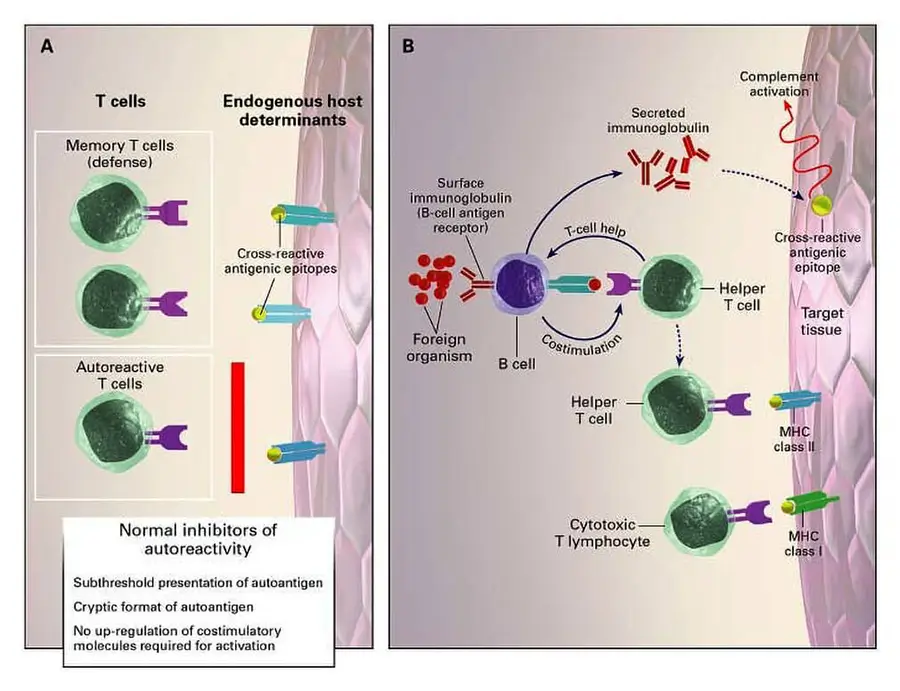
Early exposure to cow’s milk can increase the risk of diabetes in the child by about 1.5 times (Gerstein,1994).
Diabetes does not occur in those rodents that are prone to diabetes, and there was no cow’s milk in the first two to three months of life, which indicates that the cow’s milk protein can activate the disease (Karjalainen et al., 1992). This information was available for a long time, but people just did not want to believe it. In New Zealand, there was more medical controversy about this, and to this day, many farmers have moved on to their own initiative to grow cows that give A2 milk. Researchers from London and Rome announced that they were discovered by examining 47 patients with recently developing insulin-dependent diabetes mellitus (IDDM) and found that in 51% of cases, immune cells grew and multiplied when they were exposed to beta-casein protein from cow’s milk. Only 2.7% of healthy people in the control group had immune cells that responded to cow’s milk protein. Protein is a problem. There are no animals today in the world, which naturally continue to consume milk to adulthood. Cats for example will drink milk when given by humans. Every veterinary association in the world if asked would say: “Do not feed your cat with milk, because it causes kidney failure.” In cats, blood in urine and red color of urine occurs after consuming more substantial amounts of milk.
It is the same with other autoimmune diseases. Rheumatoid arthritis symptoms may flare in response to specific proteins found in dairy products and there are antibodies to milk proteins commonly found in rheumatoid arthritis patients.
Casein can trigger autoimmune reactions and may trigger more severe multiple sclerosis symptoms.
Lactose tolerance.

Lactase is an enzyme that allows the organism to digest milk sugar, and that sugar is lactose.
All mammals after rejection from sucking are lactase deficient.
They do not have contact with the milk later in life. The reaction of any organism that does not need to use the sugar lactose in adulthood is to deactivate the enzyme lactase and enzyme lactase is deactivated at the level of the genes. Except for the white Europeans, which forced their bodies for thousands of years to consume it. Thus, Danes for example, are only 2% non-tolerant, Finland 18%, Indians 50%, Israeli Jews 58%, American black people, it is interesting 70%, Ashkenazi Jews 78%, Arabs 78%, Eskimos 80%, Taiwanese 85%, Greek Cypriots 85%, Japanese 85%, Thailand 90%, Filipinos 90%, Sub Saharan Africans over 90%. WHO has put that number up, saying that it is around 95% to 100%, for Indians 90 to 100, Asians 90 to 95, Mediterranean 60 to 75 and North Americans 10 to 15, and Europeans 5 to 10 percent.
Only people of European descent can tolerate lactose, the rest of the human population cannot.
Lactose metabolism.
The enzyme lactase breaks sugar lactose on dextrose and galactose.
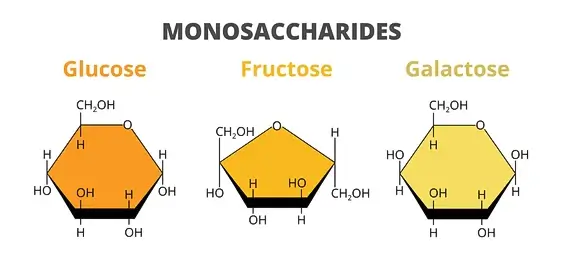
However, galactose cannot be used until it is metabolized to glucose.
There is an enzyme called beta-galactosidase that changes galactose into the glucose that we need. However, since no animal needs this enzyme after rejection, this enzyme is deactivated forever. For all of the population including lactose-tolerant individuals.
Everyone, every human on the planet Earth if it is a grown individual has galactosidase deficiency.
All of you who are reading this now have a deficiency of beta-galactosidase. This means that you consume sugar from milk meaning lactose, if you are from Europe, you can use it, and you have lactase. Lactase metabolizers lactose and you will get glucose and besides it galactose. Glucose will be used normally. And with galactose, what does the body do? We cannot use it so where does galactose go?
Some of it gets ejected outside thru the skin. Some end up in the eyes and are stored in the cornea.
Gatalctose toxicity, cataracts, and infertility.
Elderly cataracts come from galactose.
Adults who consume large amounts of milk, and have high lactase activity, often suffer from galactose toxicity, accumulation of galactitol in the eye lobe, and have a high likelihood of elderly cataracts (Postgraduate Medicine 1994). Not only that, it is stored in the body in other places as well.
Women are accumulating around the ovaries, and it is associated with cancer of the ovaries and infertility.
One in four couples goes to infertility treatments in European countries where there are large levels o dairy consumption. All of them are extremely well-fed. In African countries, where they do not consume milk, they have no problems with infertility. It is unknown as a disease.
Here’s the famous Daniel W. Cramer Harvard Medical School study (Merritt et al., 2013). Cramer saw a link between the consumption of galactose and the increased risk of ovarian cancer considering that lactose-intolerant women are likely to consume less lactose. They concluded that:
“This finding suggests that decreased lactose intake early in life may reduce ovarian cancer risk although further studies are needed to confirm this finding.
(Merritt et al., 2013)
Many studies would suggest that this sugar may affect fertility. His team compared the published data from 36 countries regarding the fertility rate, milk consumption per capita, and hypolactasia. They now published a correlation between high rates of consumption of milk and declining fertility, which begins in women who have just 20-24 years of age. This is published in the American Journal of Epidemiology. For Thai women, for example, who do not consume milk, there is no infertility at the level of statistical significance. The severity of this relationship and the decline in fertility increased with each of the following groups studied, with age increasing in each of the following groups. In Thailand for example, where 98% of adults are lactose intolerant, the average fertility among women aged 35-39 years was only 26% lower than the maximum rate for ages 25-29 years. In Australia and the UK, where lactose intolerance affects only 5% of adult people the fertility rates for 35-39 years old are full 82% below the maximum rate for 25-29 years.
What about the men? Are they immune? A study on the monkeys was carried out regarding this issue. Monkeys were given everything that monkeys eat with the addition of milk powder. The mobility of their sperm dropped. The percentage of sperm counts dropped by 2/3. There were abnormalities in the sperm count. Different defects were observed. If you consume dairy sperm counts fall by 2/3 plus reduced mobility plus defects.
Dairy is associated with lower sperm count and movement and direct testicular damage. It is as damaging to testis as cholesterol.
Constipation.
Many babies who drink cow’s milk will experience obstipation interventions where there is a special tool that physically removes excrement outside because of the impossibility of discharge.
They usually didn’t know what was the cause of children’s constipation that in some cases prolong to adulthood. So they prescribed the usual therapy of high fiber intake and laxative drugs. However, this study solved the mystery (Iacono et al., 1998). They took 65 children with chronic constipation, and all of them were treated with laxatives. They designed the study and gave them soy milk and cow’s milk and then switch them around. The ones on soy started to drink cow’s milk, and the ones drinking cow’s milk started to drink soy. In 44 out of 65 children, 68% of constipation resolved when they were on soy milk. None of the children drinking regular cow’s milk had any positive response. Some of the children have severe lesions and anal fissures, and all of that was cured when they were off the cow’s milk. Changing up cow’s milk can also help to cure anal fissures in adults also. It is nothing new. Studies around the world were able to cure constipation in children to the number of about 80% just by giving up milk. Why only 80 or 68 percent? Because giving up on milk does not mean giving up on all dairy protein. Some of the children still might consume some milk chocolate or eat ice cream or something containing powdered milk and not even be aware of it. When they design a study in 2003 that controlled for all milk protein the constipation cure rate in children was 100 percent (Crowley et al., 2013). All participants in this study experienced resolution.
Diarrhea.
On another hand in lactose-intolerant babies diarrhea occurs.
What will happen when an individual that is not tolerant of lactose drinks milk? It will cause lactose, to be broken down by bacteria in the intestines. Bacteria start to multiply, this increases osmotic pressure, fluid flows into the intestines and diarrhea follows. People of European descent do not have lactose problems, so they do not get diarrhea, but still have a massive problem with casein, galactose, sutured fat, and in recent years antibiotics and hormones, and other toxins and pesticides found in milk.
After World War 2 the U.S. had a big stockpile of powdered milk that they had to dispose of somehow. Instead, they decided that because there is a “protein gap” they should send that powdered milk to Africa as humanitarian aid. Many already malnourished children and babies got diarrhea from it. African countries that got milk powder sent as humanitarian aid experienced an increase in mortality, especially in small children who were already at the level of severe malnutrition. They drank milk concentrate, which contains lactose, got terrible diarrhea, and died. They were practically killed by poison, sent from the U.S. due to the degree of non-education in poor African populations who are not familiar with the problem of intolerance to dairy sugar. This topic is serious.
Leukemia virus.
The leukemia virus is present in 60% of milk on the market.
The antibodies of leukemia virus in cattle (BLV) are present in 59% of newborn test calves. (Canadian J of Comparative Medicine 1979). This is a bovine, not a human leukemia-causing virus. However, there can be a mutation that allows the virus to cross species. That is how we can get new strains of flu viruses from birds for example that we do not have an immune system defense and everyone gets scared when you say a bird flu virus. The same thing happens with leukemia or any other virus. Just remember HIV for instance.
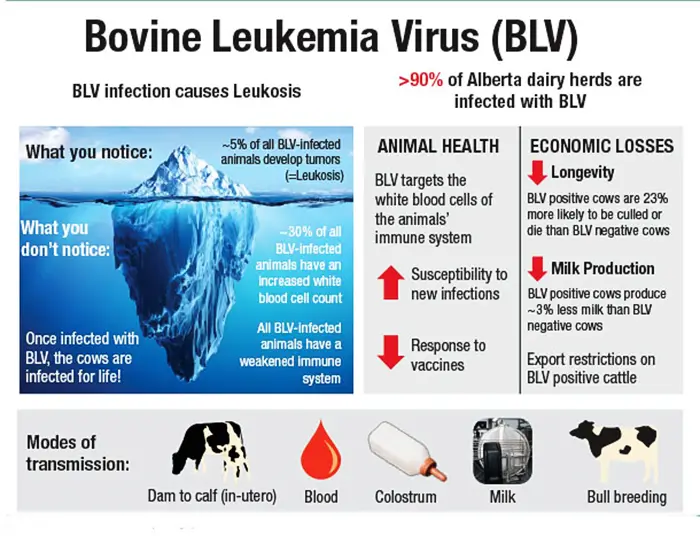
Human T cell leukemia viruses can be transmitted from humans to animals and from animals to humans. The ability of cattle leukemia virus to mutate from cattle to humans has been studied in many studies. Statistically, countries using dairy cow products have more leukemia. For example, Iowa (dairy state) has more rates than the national average for human leukemia (Donham et al., 1980). Pennsylvania veterinarians were able to cultivate BLV in human cells in a lab. Studies of 1980 showed an increase in human leukemia in areas with high rates of leukemia in cattle (Ferrer et al., 1981).
About 86% of the population in the U.S. have bovine leukemia virus antibodies detected, and by 1995 they knew that this virus works on humans as well.
This study in 2003 (Buehring et al., 2003) with much better detection equipment confirmed results from the 1980s. It showed the same thing. This is all caused by the underlying source of the entire problem. The virus makes the cows produce more milk. What cows will the farmer keep, the one that produces more milk or the one that produces less? Cows infected with BLV have significantly higher milk production than their blood donor, who is not infected with BLV. This means that much more milk is produced with BLV than previously estimated (Proceedings of the National Academy of Sciences of the United States of America, 1989). These data confirm the presence of BLV in milk and identify the potential for lactogenic (dairy) transmission of the virus (American Journal of Veterinary Research, 1995).
The bovine leukemia virus is also correlated to other types of cancers in humans, not just leukemia. It has an especially high-risk correlation to breast cancer.
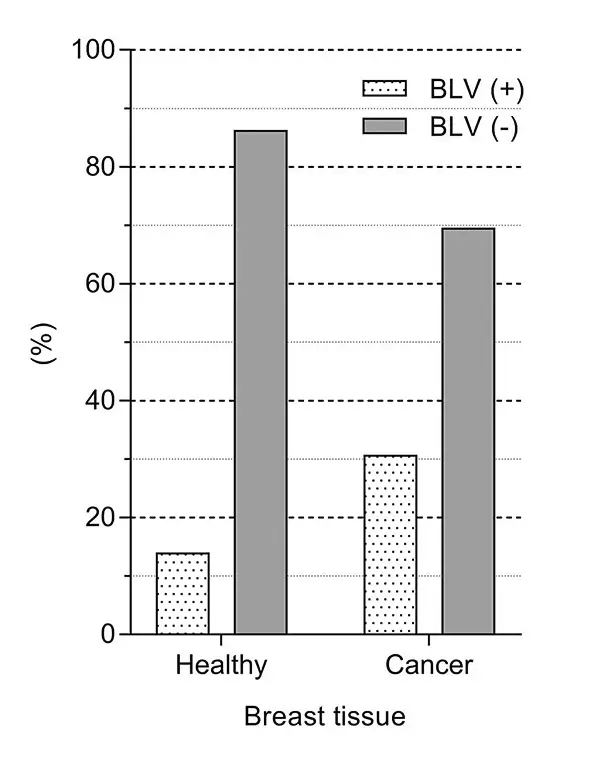
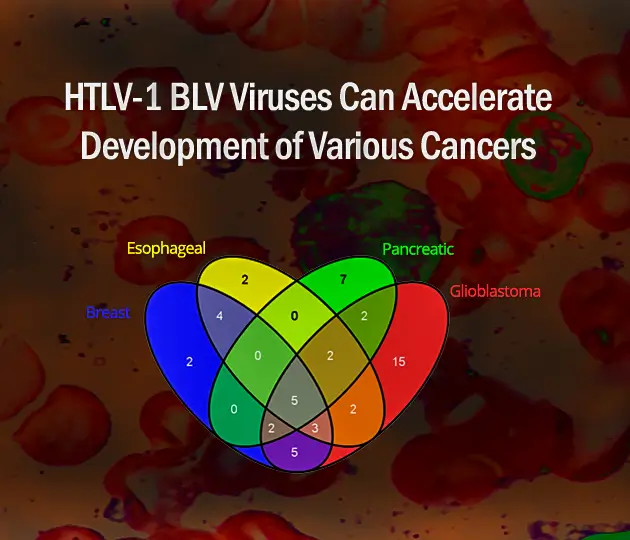
Remember these are all top scientific journals and research, not some nonsense that a local gym guru is going to debunk.
Infections diseases.
Other diseases are also transmitted through milk.
Several conditions such as tuberculosis, brucellosis, diphtheria, Scarlet fever, Q-fever, and gastroenteritis are transmitted through dairy products. Milk is an excellent transporter of infections because its fat content protects pathogens from gastric acid and since it has a relatively short gastric transient time.

Due to this milk property, pasteurization and sterilization are obligatory by law. However, these methods do not destroy all the toxins and all forms of pathogens in milk.
Pasteurization.
Pasteurization kills all of the bacteria but also some of the vital enzymes (catalase, peroxidase, phosphatase) and vitamins.
It also extends its durability for commercial use in order to prolong the fresh appearance of the milk that was kept so that the bacteria would not develop further in it. However, when enzymes such as phosphatase are destroyed, milk loses nutritional value.
Phosphatases serve to break the food in our organism so that cells can assimilate mineral salts from it that are in the form of phytate.
Unfortunately, the human organism does not have adequate levels of these phosphatase enzymes. Lack of these enzymes will cause a lowering of the absorption of minerals that are in the form of phytates. Phytic acid acts as an anti-nutritive agent by blocking the absorption of minerals such as Fe, Zn, and Ca. A phosphatase is found only in raw milk and whole grains. If pasteurization of the milk was not carried out, milk would have to be produced under far better hygienic conditions, or its poor condition would be visible by visible clumping before reaching the customer.
With pasteurization, the protein value (amino acid composition) is reduced by 17%. From the metabolic data, it is concluded that the heat is damaging to lysine and probably histidine and other amino acids and partially reduces the absorption of their nitrogen, vitamin A is destroyed, Vitamins D, E, and K are unchanged, Vitamin B complex is destroyed 38%, Vitamin C is destroyed.
Concerning calcium itself, its utilization has been significantly reduced.
Bovine somatotropin.
Bovine somatotropin or BGH was used since 1994 in the production of cattle meat and was obtained by reconstitution DNA technology.
Monsanto is the first company to develop technology, and it advertised BGH as a Savior. Recombinant bovine growth hormone (rBGH), or growth hormone in the cow stimulates the production of the second hormone Insulin-Like Growth Factor-1, or IGF-1. IGF-1 is the hormone that is directly responsible for increasing milk production. IGF-1 naturally occurs in cows and humans.
IGF-1 is not destroyed during pasteurization or digestion.
It is interesting that BGH has the same composition for both cows and humans. This is the only hormone known to have the same composition in two different species in nature and is therefore considered to be biologically active in humans.
BGH is associated with cancer (breast, prostate, and colon), and adds to another set of disorders such as premature puberty in children.
Dr. Frank M. Biro, head of the Department of Adolescent Medicine at the Cincinnati Children’s Hospital Center, and his colleagues found that 15% of Latino-American girls, more than 10% of white women, and 25% of Afro-American women started puberty as early as seven years old. The research was conducted among 1,238 children aged 6 to 8 years from various cities in the United States.

Posilac is banned in Canada, Australia, New Zealand, Japan, and EU countries. A healthy cow supplemented with Posilac® produces an average of 10 more pounds of milk per day. There is an apparent disagreement between different countries. In one country scientists find something harmless, and then the same scientists from another country consider the same substance an illegal poison. In the book Milk: The Deadly Poison, author Robert Cohen has been researching billions of dollars dairy and pharmaceutical industries spending on influencing the FDA and Congress as well as for the impact on the scientific and medical establishment.
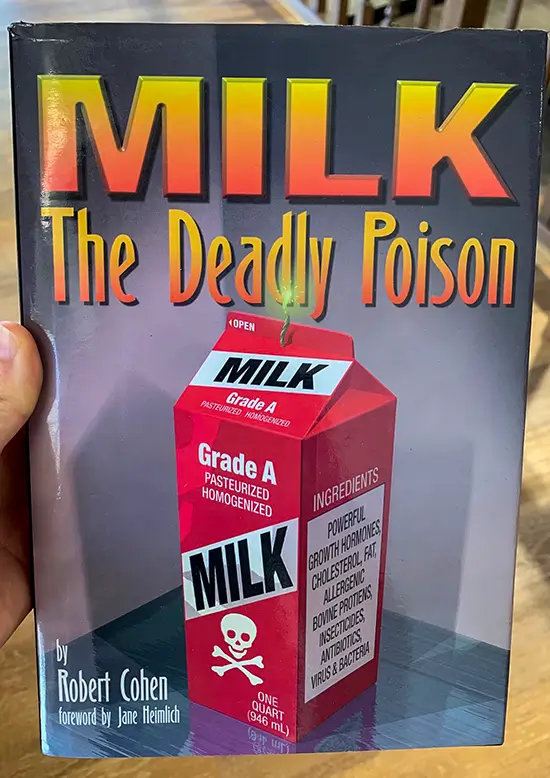
Milk today is a non-replaceable food product for a simple reason. Its rejection from human use would mean an economic problem of global proportions in a world where more than a billion people live below the poverty line. The diet itself is just as much an economic and political issue as a health issue. Chronic illnesses are the most stable source of income at the level of the military-industrial complex or at the level of oil production. Tendencies in the food industry today are the highest possible volume of production in order to achieve high profits. Currently, the food industry invests in genetically modified crops for markets that are still in development, such as Africa and countries of the third world where a high level of malnutrition is present. Demand for food products and expectations that food demand will continue to grow in the near future is all we need to know when we look at the business model of food production. What can be expected is that food prices will remain at the same level or higher, the quality of food will decrease, and genetically modified foods will be increasingly used, both in humans and in fodder.
Androgenic hormones.
Acne is an epidemic in Western countries. This skin disease affects around 85% of teenagers, but in more natural plant-eating communities like Okinawa Islanders or Kitavan Islanders, there were no cases (Melnik, 2011). Not a single one. In rural parts of China and India it very rare disease so it must come from the diet. Some people when migrating to Western countries and starting to accept the Western diet develop acne at the same level.
Acne vulgaris is an epidemic in Western countries because of the androgenic hormones that are naturally present in milk and all other dairy products. These androgenic hormones are stable and cannot be fermented or destroyed by pasteurization. There are there to promote the growth of newborn calves.
Studies had proven these hormones are in dairy products, and this has a direct effect on the oil-producing glands in human skin. The problem is that if they are androgenic, they also stimulate other things as well.
How about premature puberty?
Today we have girls that will enter puberty as young as 7-year-old. These hormones also stimulate cancer growth. Especially hormone-dependent cancer like breast and prostate cancer (Danby, 2009).
The 5alpha-pregnanedione (5alpha-P) is the main androgenic or sex hormone present in milk (Danby, 2009).
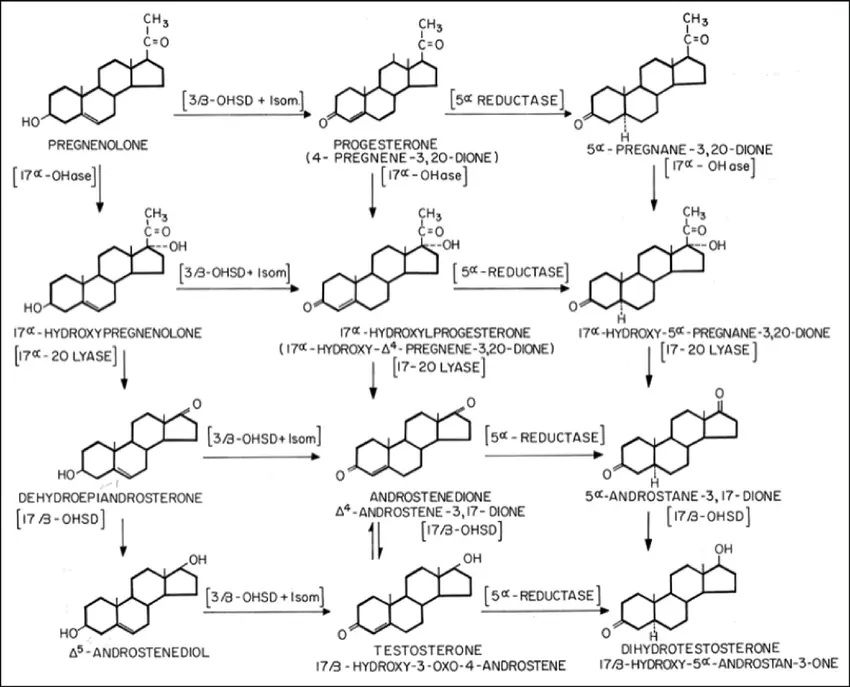
For instance, back acne is 100% exclusively caused by the overconsumption of dairy products.
The problem with these dairy sex hormones is that our bodies do not have a natural feedback loop.
These dairy sex hormones are not added artificially by the industry. Organic milk has it, and sex hormones are naturally present in all dairy products. If you are a bodybuilder and decide to inject steroids, your body will detect steroid hormones and would shut down your own production trying to keep the testosterone in a normal range. However, for 5alpha-P there is no feedback loop, our brain does not detect it and does not decrease the production of any sex hormones both testosterone or its derivate DHT and estrogen.
When you eat excessive dairy, it is as if you injected yourself with DHT and estrogen.
In our natural evolution, there was no need to develop receptors in our brains to tell us that we have cow milk sex hormones in our bodies. It is just one more maladaptation. Acne is a cosmetic issue, you can take Accutane and be done with it, but when you get breast or prostate cancer, then you can die. It all comes in a package.
Excessive DHT might give us acne and increased libido, make us go bold, and increase body hair growth. Also, it would influence prostate enlargement. Excessive estrogen is also a problem. The more serious problem of dairy consumption.
In men, it will lead to infertility in a woman it would lead to breast cancer.
All food of animal origin will have estrogen in it. Cows’ estrogen works as well as human estrogen. By drinking 300mg or one glass of milk a day a child will increase consumption of estradiol-17β the most potent form of all estrogens by 10ng.
This is 4000 times as potent as environmental exposure to xenoestrogen because of xenoestrogen’s lower level of potency (Ganmaa et al., 2001). The conclusion of this study was:
”Milk and dairy products, are responsible for 60-70% of the estrogens consumed in the western diet. Humans consume milk obtained from heifers in the latter half of pregnancy when the estrogen levels in cows are markedly elevated. The milk that we now consume may be quite unlike that consumed 100 years ago. Modern genetically-improved dairy cows, such as the Holstein, are usually fed a combination of grass and concentrates (grain/protein mixes and various by-products), allowing them to lactate during the latter half of pregnancy, even at 220 days of gestation. We hypothesize that milk is responsible, at least in part, for some male reproductive disorders.”
(Ganmaa et al., 2001)
When cows are not pregnant the amount of estrogen in milk is around 30pg/ml. However, because of the way the business is run on the farms most of the cows are pregnant, and the levels of estradiol in the pregnant cow are hundreds of times higher. For example, from 220 to 240 days of gestation, the levels of estradiol are at the maximum at 1000pg/ml. From 30 to 1000.
Osteoporosis.
There is no correlation between milk consumption and reduced risk of osteoporosis.
Someone has been spreading lies and myths (Bischoff-Ferrari et al., 2011). When we look at all the studies what we found is actually the opposite. The countries with the greatest milk consumption also have the biggest risk of osteoporosis. Not even during childhood and adolescence milk consumption have no association with bone density. It even seems that it will increase the risk later in life. These studies are so well known and so old, and everything you read here has been known by industry for decades.
The main marketing scam they use to sell dairy products is that dairy contains a lot of calcium. Numerous factors cause osteoporosis, and lack of dietary calcium is not one of them. Not even that statement that milk is full of calcium is entirely correct. It is not what you eat. It is what you absorb.
Only 25% of the calcium in cow milk is absorbable by the body, which is due to lacking digestive enzymes in humans.
Human milk, although it contains half the amount of calcium compared to cow’s milk, is a better source of calcium because of its high absorption capacity. Even certain plants like poppy seeds or sesame seeds are better sources for the same reason.
Calcium bioavailability in seeds and vegetables can vary depending on different factors, such as the presence of oxalates and phytates, which can bind to calcium and form insoluble complexes that decrease absorption. Some seeds and vegetables, such as sesame seeds, spinach, amaranth, and beet greens, have high levels of oxalates and phytates and low calcium bioavailability (less than 10%). Other plant foods, such as kale, broccoli, cabbage, celery, collard greens, soybean sprouts, and soybeans, have low levels of oxalates and phytates and high calcium bioavailability (around 20-40%). The bioavailability of calcium from these plant foods is similar to or higher than that of cow’s milk (about 30%) (Kamchan et al., 2004).
Fermentation does not influence calcium bioavailability. It is the same with cheese, yogurt, or any other dairy product and it doesn’t matter if the milk is raw or pasteurized, organic, from grass fed or not (Seiquer et al., 2010). When culture is taken, it is added to the milk, fermentation takes place, and the whey is separated. From the solid part, cheese is made. When bacteria culture consumes everything that it can we get matured cheese. The main source of energy for bacteria culture is sugar (lactose). Bacteria could not metabolize protein, so there was a lot of casein in it, they could not burn fat, so there was a lot of fat that remains in cheese. The problem is that bacteria culture does not metabolize galactose so fermented dairy products contain all of the galactose as well. Kefir, yogurt, and cheeses are the same products as milk just without the lactose. Fermented dairy products can be eaten by people sensitive to lactose, but are still full of galactose (ovarian cancer, cataract) and are very acid-forming for the body.
African women who eat vegetables and legumes and do not drink milk do not have the problem of osteoporosis. African women do not get osteoporosis on 350mg of calcium per day, and women in Europe suffer from osteoporosis at 1400mg per day. Green vegetables such as kale are as good as milk regarding calcium content. Magnesium deficiency is an actual source of osteoporosis in developed countries and to a lesser extent vitamin D deficiency. Magnesium which is mostly found in green leafy vegetables is needed to create an enzyme that regulates calcium metabolism. Also, excess calcium blocks the absorption of magnesium.
Galactose also independently from other factors causes bone loss and also creates bones that are more brittle. It is destructive to the bone matrix as much as cadmium.
Cholesterol.
Dairy products are filled with cholesterol. In experiments on rabbits, results have been obtained that the casein itself elevates the level of bad cholesterol, even without cholesterol from milk. The following results were obtained: blood cholesterol level (mg/dl), average vegetable protein 67, crude protein 101, pork protein 107, chicken protein 138, beef protein 152, protein from fish 160, protein from whole egg 176, casein from milk 203, protein from skim milk 225.
Dairy products are second on the list of all food products that raise cholesterol and this is because of casein.
Protein from milk raises cholesterol and 0% milk fat will not help you. It is the worst of them all actually. You will get cholesterol and especially bad cholesterol. Milk is bad for the heart and whole cardiovascular system and for the bones. When you have osteoporosis, doctors will recommend the standard therapy for calcium supplements. You will take more milk and create even more significant problems, and everything is worse and worse.
Recent research has confirmed that BCM7 has a pro-oxidative impact on LDL, which is widely accepted in the scientific community (Steinerová et al., 2004). Furthermore, studies examining the link between A1 beta-casein and cardiovascular disease have uncovered the underlying mechanism, demonstrating that BCM7 oxidizes LDL which carries cholesterol from the liver to the tissues (Chin-Dusting et al., 2006). This is significant since oxidized LDL boosts the risk of developing heart disease by amplifying artery incidence and plaque accumulation, as it causes arteries to become adhesive.
Opioid effects, Autism, Schizophrenia, and Sudden Infant Death Syndrome.
We are addicted to dairy products because of the taste and morphine effect. Do not give your children heroin or in other words, milk chocolate and ice cream.
Every mammalian species excrete morphine in the milk. It has evolutionary protective effects.
The newborns get addicted to opioid effects and that addiction is what pushes them to drink more of the mother’s milk and also it is what helps them sleep. If you get sleepy from drinking milk before bedtime it is because of the casomorphins.
Casomorphin is a more potent opioid than morphine itself and is responsible for most of the typical behavioral and cognitive symptoms of autism. Casomorphin ultimately causes brain damage.
Dairy products can play a significant role in the development of insomnia, difficulty sleeping, and migraine pain (Israel Journal of Medical Sciences, 1983).

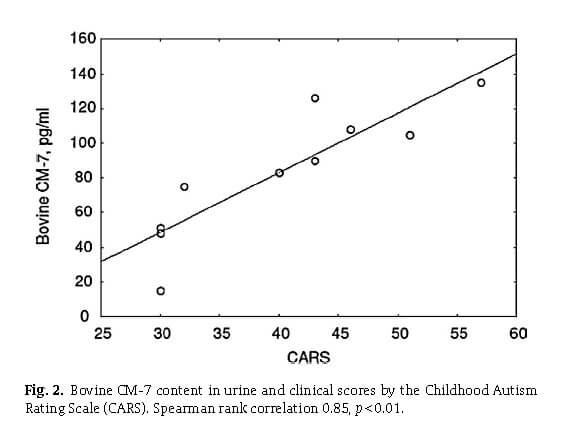
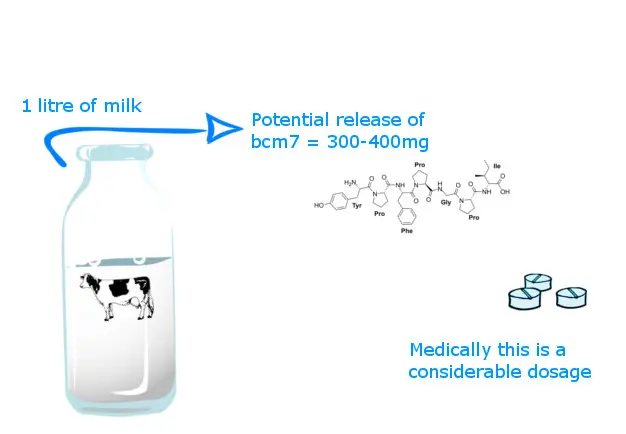
The problem is that the molecular structure of casein in human milk and cow milk differs significantly, with a similarity rate of only 47%. The effect of bovine casomorphin is much stronger than that of human casomorphin and is almost as potent as morphine (Trivedi et al., 2015). Cow casomorphins have a stronger binding affinity with serotonin receptors in the brain compared to human casomorphins. Additionally, both A1 and A2 milk produce opioid casomorphins of equal potency (Asledottir et al., 2017). Cow milk contains considerably more casein, up to 15 times more than human milk. While twenty-one peptides, including eight from beta-casein, were identified in cow milk, only five peptides, with only one from beta-casein, were identified in human milk.
And there is also a link with all diseases that depressors of the central nervous system are linked or the so-called “opioid excess theory”. The “opioid excess” theory suggests that a genetic predisposition can trigger diseases like autism and schizophrenia. Exposure to environmental stressors early on may cause damage to the gut and create inflammation, full-blown Crown disease, or a “leaky gut” condition. When dairy products are consumed, the casomorphins (opioid peptides) leak into the blood in excess and travel to the brain, where they could potentially trigger the development of neurological disorders in sensitive individuals.
Moreover, people with leaky guts and weak blood-brain barriers are more susceptible to the sedative effects of these opioid peptides. For instance, incredibly high levels of BCM7 (derived from A1 beta-casein) have been injected into rats, causing them to exhibit several symptoms related to autism and schizophrenia. Therefore, it is proposed that these peptides can penetrate through the blood-brain barrier and affect specific regions of the brain associated with these disorders.
Various studies suggest that consuming a gluten-free and casein-free diet might help reduce some of these symptoms in individuals with autism. In 2000, a team of researchers led by Robert Cade reviewed the existing evidence linking the casein and gluten opiates with autism and schizophrenia. They collected new data from 150 autistic children, 120 schizophrenia adults, 43 normal children, and 76 normal adults (Cade et al., 2000). Autistic children and schizophrenia adults showed a constant elevated abnormal value of casomorphin and gluteomorphin opioid peptides obtained from beta-casein and gluten.
Interestingly enough, opioid peptides deriving from gluten only affect three regions of the brain, while BCM7 opioids impact up to 45 regions throughout the brain. Additionally, circulating BCM7 peptides in an infant’s developing central nervous system could impair their respiratory center leading to apnea and sudden infant death syndrome (SIDS) (Sun et al, 2003). Opioid peptides from milk have long been theorized as a possible cause of sudden infant death syndrome (Ramabadran and Bansinath, 1988).
Mortality.
There is a rare birth defect known as galactosemia. It is a genetic mutation that causes a complete lack of enzymes that are needed to detoxify the galactose. Galactose cannot be turned into glucose and used as energy. Not even bacteria can eat it. It has to be detoxified. What this birth defect of galactosemia does to kids is that it causes bone loss even as kids (Batey et al., 2013). Do you know what scientists use in studies to cause premature aging in laboratory animals? They use the same thing galactose. Even in small doses, galactose increases the changes that resemble natural aging. Galactose does not just cause bone loss, because it goes everywhere it causes overall inflammation and brain damage, and degeneration also.

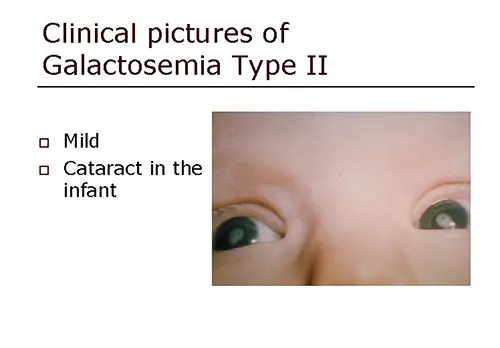
When scientists understood that milk has a toxic effect on the body, they did one big study that followed 100,000 men and women for 20 years (Michaëlsson et al., 2014). This was a cohort study done in central Sweden. The conclusion was:
“For every glass of milk, the adjusted hazard ratio of all-cause mortality was 1.15 in women and 1.03 in men. High milk intake was associated with higher mortality in one cohort of women and in another cohort of men, and with higher fracture incidence in women.”
(Michaëlsson et al., 2014)
Milk drinking was associated with inflammation, cancer, bone loss, and heart disease. This is 100,000 men and women for 20 years cohort study.
Three glasses of milk a day was had raised the total mortality association to be unbelievable 1,93!!!
That means that you have doubled your chances of dying if you drink three glasses of milk a day or 680 grams a day.
To conclude the more milk, the more death and bone fractures. That means that milk is a poison like any other poison. The association with mortality was a little lower for other milk products like kefir or yogurt or cheese, and that goes along with the galactose theory very well. Bacteria that ferment lactose to create yogurt or cheese can partially lower the galactose content. Not completely just partially.
You can try to drink low-fat lactose-free milk, but then you are just consuming milk protein that is bad just by itself.
Parkinson’s disease and neurotoxicity.
The food item most associated with Parkinson’s disease is milk. In all the studies ever done, the association with milk was absolute. At first, the scientist did not know what to think about it. They thought it is some neurotoxin that must be present in milk like organochlorine residues or pesticides. However, if pesticides or organochlorine residues or whatever other toxin is a cause of Parkinson’s disease, there is no logical explanation for why there is no correlation between other food items that have the same toxins and Parkinson’s. Or for example, pesticides build up in fat, but the link between skim milk and Parkinson’s is as strong as full-fat milk. And then because they were unable to explain the association they said it is reverse causation. Parkinson’s disease causes people to become depressed and depressed people drink more milk. However, prospective cohort studies still were finding a link between milk and Parkinson excluding the reverse causation explanation (Jiang et al., 2014). The linear dose-response relationship showed that PD risk increased by 17% [1.17 (1.06-1.30)] for every 200 g/day increments in milk intake and 13% for every slice of cheese.
Neurotoxins are found in all dairy products so why does cheese have a lower association? And the only thing that cheese has lower than milk is galactose content. There are other neurodegenerative diseases like Huntington’s disease that run in families. In Huntington, the risk is a 2-fold increase meaning the early onset is doubled by dairy consumption. In some people, genetic predisposition can be worsened by galactose, and in all people, the negative effect of galactose will increase the risk of all diseases that it has been associated with including bone loss. In people with galactosemia, 20% of them develop a severe form of progressive tremor and ataxia. People with galactosemia learn not to consume the stuff, but until they learn that they have the condition they do consume it, and some of them end later end up with tremors and ataxia.
We know that galactose is a neurotoxin just like any other neurotoxin that can cause such issues as ataxia which means you cannot voluntarily move your body.
What about lymphocytes? If you want to help with your immune system, reduce milk in the diet (especially if you have HIV and other serious diseases). Cow milk consumption can weaken the immune function in children and lead to the return of infections (Delire et al., 1978).
Blood vessels.
Why don’t we take a look at what happened to the blood vessels of milk-eating monkeys? When only a little milk was added, the first thing to go was good and the bad cholesterol ratio. In the picture, you have pictures of the main arteries. The first is crystal clear (988), which is for a monkey who ate corn and legumes. All small vessels are open. This second (920) is for the monkey who consumed milk with corn. Closed everywhere plus a plaque.

Because they have to drain so much calcium to neutralize the casein, the kidneys cannot get rid of it in time. That is why it sticks down to the blood vessels, and you get calcium deposits (picture on the left). Blood vessels become brittle, and the risk of their cracking and blood spilling into the brain (stroke) rises. It is not just milk that would cause this. It is milk or dairy products plus a high protein or excess protein diet as a whole that leads to calcium deposits on the blood vessels.
And this is very controversial because there is an entire industry with hidden influence and agenda in promoting dairy that translates into research. And when the research funded by the agenda gets averaged at the aggregate level we get conflicting results and for the industry and government, this is more then enough to maintain the status quo. It is up to you to take care of yourself and to find out what is objective truth. One study founds increased risk, and another no risk at an average level in meta-analysis we get noting. For example, a recent umbrella review (Zhang et al., 2021) summarized the evidence of milk consumption and various health outcomes, including cardiovascular diseases. The review found that milk consumption was more often related to benefits than harm for health outcomes and that an increment of 200 ml milk intake per day was actually associated with a lower risk of cardiovascular disease, stroke, hypertension, metabolic syndrome, obesity, and osteoporosis if you can actually believe that. The review only found that milk intake might be associated with a higher risk of prostate cancer, Parkinson’s disease, acne, and Fe-deficiency anemia in infancy. I have broth to you independent reviews of studies that do not go well with the industry and actually don’t go well with most of the people who want conflicting results to rationalize dairy consumption because dairy is the most addictive food of all. Or maybe I just have a secret agenda to promote a plant-based diet and lose my time, energy, and money for whatever reason. You do your own research and you decide. In the end, there is one truth that can’t be denied.
There are no nutrients in dairy products that are unique that we would not be able to consume from healthy food choices.
Milos Pokimica
Calcium is not bioavailable from dairy products before or after pasteurization. Sesame seeds have 975 mg of calcium in 100 grams of seeds. Poppy seeds have 1.438 mg in 100 grams of seeds. But seeds also have a lot of calories and are higher in oxalates.
Per calorie basis geens and for example kale especially because of its low oxalate content is a good source of calcium.
| Food | Calcium per serving |
|---|---|
| Poppy seeds (30g) | 432 mg |
| Sesame seeds (30g) | 201 mg |
| Chia seeds (30g) | 189 mg |
| Calcium-fortified soy milk (200ml) | 240 mg |
| Calcium-fortified oat milk (200ml) | 240 mg |
| Calcium-fortified almond milk (200ml) | 240 mg |
| Calcium-fortified coconut milk (200ml) | 240 mg |
| Calcium-set tofu (100g) | 350 mg |
| Kale (80g cooked) | 185 mg |
| Figs (30g dried) | 75 mg |
| Almonds (30g whole kernels) | 81 mg |
If you are concerned about protein and you should not be because excess protein is correlated to many diseases including cancer and acidosis, then any protein source in existence is better than schizophrenia, autism, opioid, LDL oxidizing, diabetes-inducing casein from milk. Take a scoop of whey protein isolate if you want dairy protein for some reason in your diet, it is much better than casein.
One thing I found people who want to change their diet have the hardest time getting rid of is cheese and dairy. The meat they can do, but cheese is hard. People who eat a vegetarian diet would not reap the full health benefits of a whole food plant-based diet. They just substitute one animal protein like meat for another like eggs and dairy. Same toxins, hormones, and inflammation effects. Same IGF-1 level same everything. If you want to have health benefits, you must treat the milk and eggs the same way as you treat meat. As a survival food that is toxic to the body that we can tolerate in small amounts if we do not want to have all of the diseases of affluence. Giving up meat to eat ice cream all day long is not going to do much for your health. Except drugging your brain with casomorphins and exposing you to the risk of cancer and diabetes.
In the video below Dr. Neal Barnard has a full one-hour talk on cheese, milk, and the many reasons you want to break the dairy addiction.
Conclusion:
- The ordinary wild cow will produce 3 liters of milk per day.
- Domesticated genetically conditioned cows would produce 40 to 80 liters of milk per day.
- The World Champion has produced over 120 liters a day.
- The protein in milk is called Casein.
- Casein needs a particular enzyme called rennin so that the body can dissolve it into amino acids.
- Human milk has the lowest concentration of proteins of all other mammal species.
- Human milk has the lowest proportion of casein to whey of all other mammal species.
- The casein from each species is uniquely suited to meet the metabolic needs of that species, which means that it will have a specific amino acid composition.
- The amount of protein in milk is uniquely suited to meet the growing needs of that species.
- The more protein the milk has the faster the growth rate of that species is.
- There is a much higher fat ratio in human milk in relation to a protein that is perfect for brain development.
- Infants fed with any other milk than their mother’s milk have lower IQs at an average level.
- Feeding infants with cow’s milk leads to an 80% probability of getting diarrhea and a 70% probability of an outbreak of ear infections compared to infants nourished with mother’s milk.
- Babies fed with cow’s milk during the other six months of life have a 30% increase in blood loss in internal organs and a significant loss of iron in their stool and low intakes of iron in general, linoleic acid, and vitamin E, and excessive intakes of sodium, potassium, and protein.
- Diabetes type 1 has long been known to correlate to milk consumption or more specifically cow’s milk and dairy. Not all milk.
- Early exposure to cow’s milk can increase the risk of diabetes in the child by about 1.5 times.
- There is an amino acid sequence in one part of the casein from European breeds (A1 beta-casein) that turned out to be the same as the amino acid sequence in beta cells in the human pancreas.
- Humans cannot digest the casein properly.
- Because human milk has so little protein human babies as well do not need to have all that rennin for casein digestion.
- Slow digestion of casein is a consequence of lacking evolutionary adaptation to milk drinking.
- Many babies who drink cow’s milk will experience obstipation interventions.
- All mammals after rejection from sucking are lactase deficient.
- Only people of European descent can tolerate lactose, the rest of the human population cannot.
- Lactose-intolerant people who drink cow’s milk will experience diarrhea.
- The enzyme lactase breaks sugar lactose on dextrose and galactose.
- Galactose cannot be used until it is digested in glucose. There is an enzyme called beta-galactosidase that changes galactose in glucose.
- Everyone, every human on the planet Earth if it is a grown individual has galactosidase deficiency.
- Elderly cataracts come from galactose.
- Women are accumulating galactose around the ovaries, and it is associated with cancer of the ovaries and infertility.
- Even in small doses, galactose increases the changes that resemble natural aging.
- The leukemia virus is present in 60% of milk on the market.
- Human T cell leukemia viruses can be transmitted from humans to animals and from animals to humans.
- Statistically, countries using dairy cow products have more leukemia.
- About 86% of the population in the U.S. have bovine leukemia virus antibodies detected.
- Cows infected with BLV have significantly higher milk production than their blood donor, who is not infected with BLV.
- The bovine leukemia virus is also correlated to other types of cancers in humans, not just leukemia. It has an especially high-risk correlation to breast cancer.
- Several conditions such as tuberculosis, brucellosis, diphtheria, Scarlet fever, Q-fever, and gastroenteritis are transmitted through dairy products.
- Pasteurization kills all of the bacteria but also some of the vital enzymes (catalase, peroxidase, phosphatase) and vitamins.
- Phosphatases serve to break the food in our organism so that cells can assimilate mineral salts from it that are in the form of phytate.
- reduces protein value (amino acid composition) by 17%, vitamin B complex is destroyed by 38%, and vitamin C is destroyed.
- Concerning calcium itself, its utilization has been significantly reduced by pasteurization.
- Bovine somatotropin or BGH was used since 1994 in the production of cattle meat and was obtained by reconstitution DNA technology.
- BGH has the same composition for both cows and humans.
- BGH is associated with cancer (breast, prostate, and colon), and adds to another set of disorders such as premature puberty in children.
- Androgenic hormones are naturally present in milk and all other dairy products and cannot be fermented or destroyed by pasteurization.
- Androgenic hormones promote the development of acne vulgaris, and premature puberty and stimulate cancer growth.
- The 5alpha-pregnanedione (5alpha-P) is the androgenic or sex hormone present in milk.
- The problem with dairy sex hormones is that our bodies do not have a natural feedback loop.
- By drinking 300mg or one glass of milk a day a child will increase consumption of estradiol-17β the most potent form of all estrogens by 10ng.
- Milk and dairy products are responsible for 60-70% of the estrogens consumed in the Western diet.
- Humans consume milk obtained from heifers in the latter half of pregnancy when the estrogen levels in cows are markedly elevated. The milk that we now consume may be quite unlike that consumed 100 years ago.
- Dairy is associated with lower sperm count and movement and direct testicular damage. It is as damaging to testis as cholesterol.
- Only 25% of the calcium in cow milk is absorbable by the body after pasteurization, which is due to destroyed enzymes.
- In experiments on rabbits, results have been obtained that the casein itself elevates the level of bad cholesterol, even without cholesterol from milk.
- Dairy products are second on the list of all food products that raise cholesterol and this is because of casein.
- For every glass of milk, the adjusted hazard ratio of all-cause mortality was 1.15 in women and 1.03 in men.
- Three glasses of milk a day was had raised the total mortality association to be unbelievable 1,93.
- Every mammalian species excrete morphine in the milk. It has evolutionary protective effects.
- Casomorphin is a more potent opioid than morphine itself and is responsible for most of the typical behavioral and cognitive symptoms of autism.
- Casomorphin ultimately causes brain damage.
- The food item most associated with Parkinson’s disease is milk.
- Dairy products can play a significant role in the development of insomnia, difficulty sleeping, and migraine pain.
- Cow milk consumption can weaken the immune function in children and lead to the return of infections.
FAQ
References:
- Scariati, P. D., Grummer-Strawn, L. M., & Fein, S. B. (1997). A longitudinal analysis of infant morbidity and the extent of breastfeeding in the United States. Pediatrics, 99(6), E5. https://doi.org/10.1542/peds.99.6.e5
- Scott F. W. (1990). Cow milk and insulin-dependent diabetes mellitus: is there a relationship?. The American journal of clinical nutrition, 51(3), 489–491. https://doi.org/10.1093/ajcn/51.3.489
- Cramer, D. W., Harlow, B. L., Willett, W. C., Welch, W. R., Bell, D. A., Scully, R. E., Ng, W. G., & Knapp, R. C. (1989). Galactose consumption and metabolism in relation to the risk of ovarian cancer. Lancet (London, England), 2(8654), 66–71. https://doi.org/10.1016/s0140-6736(89)90313-9
- “The Use of Whole Cow’s Milk in Infancy.” (1992b). Pediatrics, 89(6), 1105–1109. https://doi.org/10.1542/peds.89.6.1105
- Simoons F. J. (1982). A geographic approach to senile cataracts: possible links with milk consumption, lactase activity, and galactose metabolism. Digestive diseases and sciences, 27(3), 257–264. https://doi.org/10.1007/BF01296925
- Gerstein H. C. (1994). Cow’s milk exposure and type I diabetes mellitus. A critical overview of the clinical literature. Diabetes care, 17(1), 13–19. https://doi.org/10.2337/diacare.17.1.13
- Karjalainen, J., Martin, J. M., Knip, M., Ilonen, J., Robinson, B. H., Savilahti, E., Akerblom, H. K., & Dosch, H. M. (1992). A bovine albumin peptide as a possible trigger of insulin-dependent diabetes mellitus. The New England journal of medicine, 327(5), 302–307. https://doi.org/10.1056/NEJM199207303270502
- Postgraduate Medicine 1994; 95 (1): 115
- Merritt, M. A., Cramer, D. W., Vitonis, A. F., Titus, L. J., & Terry, K. L. (2013). Dairy foods and nutrients in relation to risk of ovarian cancer and major histological subtypes. International journal of cancer, 132(5), 1114–1124. https://doi.org/10.1002/ijc.27701
- Iacono, G., Cavataio, F., Montalto, G., Florena, A., Tumminello, M., Soresi, M., Notarbartolo, A., & Carroccio, A. (1998). Intolerance of cow’s milk and chronic constipation in children. The New England journal of medicine, 339(16), 1100–1104. https://doi.org/10.1056/NEJM199810153391602
- Crowley, E. T., Williams, L. T., Roberts, T. K., Dunstan, R. H., & Jones, P. D. (2013). Does Milk Cause Constipation? A Crossover Dietary Trial. Nutrients, 5(1), 253-266. https://doi.org/10.3390/nu5010253
- Canadian J of Comparative Medicine 1979; 43 (2): 173-179
- Donham, K. J., Berg, J. W., & Sawin, R. S. (1980). Epidemiologic relationships of the bovine population and human leukemia in Iowa. American journal of epidemiology, 112(1), 80–92. https://doi.org/10.1093/oxfordjournals.aje.a112979
- Ferrer, J. F., Kenyon, S. J., & Gupta, P. (1981). Milk of Dairy Cows Frequently Contains a Leukemogenic Virus. Science.
- Buehring, G. C., Philpott, S. M., & Choi, K. Y. (2003). Humans have antibodies reactive with Bovine leukemia virus. AIDS research and human retroviruses, 19(12), 1105–1113. https://doi.org/10.1089/088922203771881202
- Proceedings of the National Academy of Sciences of the United States of America (1989) Bovine leukemia virus infection in dairy and beef herds: correlation with production and association with lymphocytosis. Proceedings of the National Academy of Sciences of the United States of America , 86(2), 445–449.
- American Journal of Veterinary Research (1995) Detection of bovine leukemia virus in blood and milk by nested and conventional polymerase chain reaction. American Journal of Veterinary Research, 56(8), 1016–1020.
- Melnik B. C. (2011). Evidence for acne-promoting effects of milk and other insulinotropic dairy products. Nestle Nutrition workshop series. Paediatric programme, 67, 131–145. https://doi.org/10.1159/000325580
- Danby F. W. (2009). Acne, dairy and cancer: The 5alpha-P link. Dermato-endocrinology, 1(1), 12–16. https://doi.org/10.4161/derm.1.1.7124
- Ganmaa, D., Wang, P. Y., Qin, L. Q., Hoshi, K., & Sato, A. (2001). Is milk responsible for male reproductive disorders?. Medical hypotheses, 57(4), 510–514. https://doi.org/10.1054/mehy.2001.1380
- Bischoff-Ferrari, H. A., Dawson-Hughes, B., Baron, J. A., Kanis, J. A., Orav, E. J., Staehelin, H. B., Kiel, D. P., Burckhardt, P., Henschkowski, J., Spiegelman, D., Li, R., Wong, J. B., Feskanich, D., & Willett, W. C. (2011). Milk intake and risk of hip fracture in men and women: a meta-analysis of prospective cohort studies. Journal of bone and mineral research : the official journal of the American Society for Bone and Mineral Research, 26(4), 833–839. https://doi.org/10.1002/jbmr.279
- Batey, L. A., Welt, C. K., Rohr, F., Wessel, A., Anastasoaie, V., Feldman, H. A., Guo, C. Y., Rubio-Gozalbo, E., Berry, G., & Gordon, C. M. (2013). Skeletal health in adult patients with classic galactosemia. Osteoporosis international : a journal established as result of cooperation between the European Foundation for Osteoporosis and the National Osteoporosis Foundation of the USA, 24(2), 501–509. https://doi.org/10.1007/s00198-012-1983-0
- Michaëlsson, K., Wolk, A., Langenskiöld, S., Basu, S., Lemming, E. W., Melhus, H., & Byberg, L. (2014). Milk intake and risk of mortality and fractures in women and men: cohort studies. BMJ, 349(oct27 1), g6015. https://doi.org/10.1136/bmj.g6015
- Jiang, W., Ju, C., Jiang, H., & Zhang, D. (2014). Dairy foods intake and risk of Parkinson’s disease: a dose-response meta-analysis of prospective cohort studies. European journal of epidemiology, 29(9), 613–619. https://doi.org/10.1007/s10654-014-9921-4
- Delire, M., Cambiaso, C. L., & Masson, P. L. (1978). Circulating immune complexes in infants fed on cow’s milk. Nature, 272(5654), 632. https://doi.org/10.1038/272632a0
- Virtanen, S. M., Saukkonen, T., Savilahti, E., Ylönen, K., Räsänen, L., Aro, A., Knip, M., Tuomilehto, J., & Akerblom, H. K. (1994). Diet, cow’s milk protein antibodies and the risk of IDDM in Finnish children. Childhood Diabetes in Finland Study Group. Diabetologia, 37(4), 381–387. https://doi.org/10.1007/s001250050121
- Israel Journal of Medical Sciences, 1983; 19 (9): 806-809; Pediatrics, 1989; 84 (4): 595-603
- Chia, J. S. J., McRae, J. L., Kukuljan, S., Woodford, K., Elliott, R. B., Swinburn, B., & Dwyer, K. M. (2017). A1 beta-casein milk protein and other environmental pre-disposing factors for type 1 diabetes. Nutrition & diabetes, 7(5), e274. https://doi.org/10.1038/nutd.2017.16
- Pal, S., Woodford, K., Kukuljan, S., & Ho, S. (2015). Milk Intolerance, Beta-Casein and Lactose. Nutrients, 7(9), 7285-7297. https://doi.org/10.3390/nu7095339
- Laugesen, M., & Elliott, R. (2003). Ischaemic heart disease, Type 1 diabetes, and cow milk A1 beta-casein. The New Zealand medical journal, 116(1168), U295. [PubMed]
- Steinerová, A., Racek, J., Stozický, F., Tatzber, F., & Lapin, A. (1999). Autoantibodies against oxidized LDL in the first phase of life. Low density lipoproteins. Clinical chemistry and laboratory medicine, 37(9), 913–917. https://doi.org/10.1515/CCLM.1999.135
- Kost, N. V., Sokolov, O. Y., Kurasova, O. B., Dmitriev, A. D., Tarakanova, J. N., Gabaeva, M. V., Zolotarev, Y. A., Dadayan, A. K., Grachev, S. A., Korneeva, E. V., Mikheeva, I. G., & Zozulya, A. A. (2009). Beta-casomorphins-7 in infants on different type of feeding and different levels of psychomotor development. Peptides, 30(10), 1854–1860. https://doi.org/10.1016/j.peptides.2009.06.025
- Chin-Dusting, J., Shennan, J., Jones, E., Williams, C., Kingwell, B., & Dart, A. (2006). Effect of dietary supplementation with beta-casein A1 or A2 on markers of disease development in individuals at high risk of cardiovascular disease. The British journal of nutrition, 95(1), 136–144. https://doi.org/10.1079/bjn20051599
- Trivedi, M. S., Hodgson, N., Walker, S. G., Trooskens, G., Nair, V., & Deth, R. C. (2015). Epigenetic effects of casein-derived opioid peptides in SH-SY5Y human neuroblastoma cells. Nutrition & Metabolism, 12(1). https://doi.org/10.1186/s12986-015-0050-1
- Asledottir, T., Le, T. T., Petrat-Melin, B., Devold, T. G., Larsen, L. B., & Vegarud, G. E. (2017). Identification of bioactive peptides and quantification of β-casomorphin-7 from bovine β-casein A1, A2 and I after ex vivo gastrointestinal digestion. International Dairy Journal, 71, 98-106. https://doi.org/10.1016/j.idairyj.2017.03.008
- Cade, R., Privette, M., Fregly, M., Rowland, N., Sun, Z., Zele, V., Wagemaker, H., & Edelstein, C. (2000). Autism and Schizophrenia: Intestinal Disorders. Nutritional neuroscience, 3(1), 57–72. https://doi.org/10.1080/1028415X.2000.11747303
- Ramabadran, K., & Bansinath, M. (1988). Opioid peptides from milk as a possible cause of sudden infant death syndrome. Medical hypotheses, 27(3), 181–187. https://doi.org/10.1016/0306-9877(88)90138-7
- Sun, Z., Zhang, Z., Wang, X., Cade, R., Elmir, Z., & Fregly, M. (2003). Relation of beta-casomorphin to apnea in sudden infant death syndrome. Peptides, 24(6), 937–943. https://doi.org/10.1016/s0196-9781(03)00156-6
- Zhang, X., Chen, X., Xu, Y., Yang, J., Du, L., Li, K., & Zhou, Y. (2021). Milk consumption and multiple health outcomes: umbrella review of systematic reviews and meta-analyses in humans. Nutrition & metabolism, 18(1), 7. https://doi.org/10.1186/s12986-020-00527-y
- Campbell TC & Campbell TM II (2006) The China Study: The Most Comprehensive Study of Nutrition Ever Conducted and the Startling Implications for Diet, Weight Loss and Long-term Health . Dallas: BenBella Books.
- Buehring, G. C., Shen, H. M., Jensen, H. M., Choi, K. Y., Sun, D., & Nuovo, G. (2014). Bovine leukemia virus DNA in human breast tissue. Emerging infectious diseases, 20(5), 772–782. https://doi.org/10.3201/eid2005.131298
- Seiquer, I., Delgado-Andrade, C., Haro, A., & Navarro, M. P. (2010). Assessing the effects of severe heat treatment of milk on calcium bioavailability: in vitro and in vivo studies. Journal of dairy science, 93(12), 5635–5643. https://doi.org/10.3168/jds.2010-3469
- Kamchan, A., Puwastien, P., Sirichakwal, P. P., & Kongkachuichai, R. (2004). In vitro calcium bioavailability of vegetables, legumes and seeds. Journal of Food Composition and Analysis, 17(3-4), 311-320. https://doi.org/10.1016/j.jfca.2004.03.002
Related Posts
Do you have any questions about nutrition and health?
I would love to hear from you and answer them in my next post. I appreciate your input and opinion and I look forward to hearing from you soon. I also invite you to follow us on Facebook, Instagram, and Pinterest for more diet, nutrition, and health content. You can leave a comment there and connect with other health enthusiasts, share your tips and experiences, and get support and encouragement from our team and community.
I hope that this post was informative and enjoyable for you and that you are prepared to apply the insights you learned. If you found this post helpful, please share it with your friends and family who might also benefit from it. You never know who might need some guidance and support on their health journey.
– You Might Also Like –

Learn About Nutrition
Milos Pokimica is a doctor of natural medicine, clinical nutritionist, medical health and nutrition writer, and nutritional science advisor. Author of the book series Go Vegan? Review of Science, he also operates the natural health website GoVeganWay.com
Medical Disclaimer
GoVeganWay.com brings you reviews of the latest nutrition and health-related research. The information provided represents the personal opinion of the author and is not intended nor implied to be a substitute for professional medical advice, diagnosis, or treatment. The information provided is for informational purposes only and is not intended to serve as a substitute for the consultation, diagnosis, and/or medical treatment of a qualified physician or healthcare provider.NEVER DISREGARD PROFESSIONAL MEDICAL ADVICE OR DELAY SEEKING MEDICAL TREATMENT BECAUSE OF SOMETHING YOU HAVE READ ON OR ACCESSED THROUGH GoVeganWay.com
NEVER APPLY ANY LIFESTYLE CHANGES OR ANY CHANGES AT ALL AS A CONSEQUENCE OF SOMETHING YOU HAVE READ IN GoVeganWay.com BEFORE CONSULTING LICENCED MEDICAL PRACTITIONER.
In the event of a medical emergency, call a doctor or 911 immediately. GoVeganWay.com does not recommend or endorse any specific groups, organizations, tests, physicians, products, procedures, opinions, or other information that may be mentioned inside.
Editor Picks –
Milos Pokimica is a health and nutrition writer and nutritional science advisor. Author of the book series Go Vegan? Review of Science, he also operates the natural health website GoVeganWay.com
Latest Articles –
Top Health News — ScienceDaily
- This cancer-fighting molecule took 50 years to buildon December 22, 2025
MIT scientists have achieved the first-ever lab synthesis of verticillin A, a complex fungal compound discovered in 1970. Its delicate structure stalled chemists for decades, despite differing from related molecules by only two atoms. With the synthesis finally complete, researchers created new variants that showed strong activity against a rare pediatric brain cancer. The breakthrough could unlock an entire class of previously unreachable cancer-fighting molecules.
- A new drug could stop Alzheimer’s before memory loss beginson December 22, 2025
New research suggests Alzheimer’s may start far earlier than previously thought, driven by a hidden toxic protein in the brain. Scientists found that an experimental drug, NU-9, blocks this early damage in mice and reduces inflammation linked to disease progression. The treatment was given before symptoms appeared, targeting the disease at its earliest stage. Researchers say this approach could reshape how Alzheimer’s is prevented and treated.
- Why one long walk may be better than many short oneson December 22, 2025
How you walk may matter just as much as how much you walk. A large UK study tracking more than 33,000 low-activity adults found that people who grouped their daily steps into longer, uninterrupted walks had dramatically lower risks of early death and heart disease than those who moved in short, scattered bursts.
- Parkinson’s breakthrough changes what we know about dopamineon December 22, 2025
A new study shows dopamine isn’t the brain’s movement “gas pedal” after all. Instead of setting speed or strength, it quietly enables movement in the background, much like oil in an engine. When scientists manipulated dopamine during movement, nothing changed—but restoring baseline dopamine levels made a big difference. The finding could reshape how Parkinson’s disease is treated.
- A traditional Brazilian plant shows unexpected strength against arthritison December 22, 2025
A Brazilian study has confirmed that Joseph’s Coat, a plant used for generations in folk medicine, can significantly reduce inflammation and arthritis symptoms in lab tests. Researchers observed less swelling, healthier joints, and signs of tissue protection. Just as important, the extract showed a promising safety profile at tested doses. The discovery could pave the way for new plant-based anti-inflammatory treatments.
- Study links full-fat cheese to lower dementia riskon December 22, 2025
Eating full-fat cheese and cream may be associated with a lower risk of dementia, according to a large study that tracked people for more than 25 years. Those who consumed higher amounts of these foods developed dementia less often than those who ate little or none. Interestingly, low-fat dairy products did not show the same pattern. Researchers caution that the findings show an association, not cause and effect.
- Science says we’ve been nurturing “gifted” kids all wrongon December 21, 2025
A major international review has upended long-held ideas about how top performers are made. By analyzing nearly 35,000 elite achievers across science, music, chess, and sports, researchers found that early stars rarely become adult superstars. Most world-class performers developed slowly and explored multiple fields before specializing. The message is clear: talent grows through variety, not narrow focus.
PubMed, #vegan-diet –
- Comparing diet-related attitudes, perceptions, and behaviors of vegan and omnivorous adults: results from a cross-sectional survey study in Germanyon December 22, 2025
CONCLUSION: The findings are consistent with and build on existing research on cognitive and behavioral patterns related to a vegan diet, while at the same time yielding some additional insights. In particular, the results on significant differences in the risk-benefit perception of a vegan diet, as well as on motivations and influences regarding the decision to follow a vegan diet provide an important basis for the development of public health interventions and a foundation for further […]
- Assessment of vitamin A, vitamin B2, vitamin B12, vitamin K, folate, and choline status following 4 months of multinutrient supplementation in healthy vegans: a randomised,…on December 19, 2025
CONCLUSION: A multinutrient supplement containing 82 µg of vitamin B(12) per day significantly positively affected vitamin B(12) blood biomarkers in healthy vegans.
- Exploring the synergistic potential of pH and ultrasonication on the functional properties of pea and lentil protein isolates and its formulation in food producton December 15, 2025
The substitution of meat proteins with plant-based proteins from various sources is often motivated by nutritional considerations. However, the inherent limited solubility of plant proteins, which results in suboptimal techno-functional properties, remains a persistent challenge in food formulation. The purpose of this study was to utilize unique properties of pea (Pisum sativum L.) and lentil (Lens culinaris) through ultrasonication and pH variation in order to develop a stable and […]
- Healthful and Unhealthful Plant-Based Diets and Their Association with Cardiometabolic Targets in Women Diagnosed with Breast Cancer: A Cross-Sectional Analysis of a Lifestyle Trialon December 11, 2025
CONCLUSIONS: Maintaining cardiometabolic risk factors within normal ranges is clinically relevant in BCS, and this may be more likely when a plant-based diet is consumed, especially if low in unhealthy plant foods.
- Functional and Nutritional Properties of Lion’s Mane Mushrooms in Oat-Based Desserts for Dysphagia and Healthy Ageingon December 11, 2025
Hericium erinaceus (Lion’s Mane mushroom) is a medicinal species recognised for its neuroprotective and antioxidant properties. This study investigated its potential as a functional ingredient in oat milk-based desserts formulated for individuals with dysphagia. Freeze-dried Lion’s Mane powder (LMP), containing high-quality protein (~16%, amino acid score 88%), dietary fibre (~31%), and phenolic compounds (72.15 mg GAE/g), was incorporated at varying levels using gelatin or iota-carrageenan […]
Random Posts –
Featured Posts –
Latest from PubMed, #plant-based diet –
- Associations Between Healthy and Plant-Based Dietary Patterns and Cognitive Reserve: A Cross-Sectional Analysis of the 1946 British Birth Cohortby Kelly C Cara on December 23, 2025
CONCLUSIONS: CR was positively associated with healthy dietary patterns and inversely associated with unhealthful plant-based dietary patterns. Diet uniquely explained variations in CR and should be considered among influential lifestyle factors in future research. Longitudinal analyses are needed to confirm these findings.
- Dietary quercetagetin attenuates H2O2-induced oxidative damage and preserves meat quality in broilers by modulating redox status and Nrf2/ferroptosis signaling pathwayby Wenyue Hu on December 22, 2025
In modern poultry production, oxidative stress has emerged as a pivotal factor compromising the health status and overall performance of broiler. The aim of this study was to investigate the effects of dietary quercetagetin (QG) supplementation on hydrogen peroxide (H(2)O(2))-induced oxidative damage in breast muscle of broilers, focusing on growth performance, meat quality, and antioxidant function, and elucidating the underlying mechanisms. Two hundred and forty one-day-old Cobb broilers […]
- Effects of dietary selenium supplementation on physiological parameters, tissue fatty acid composition, and fatty acid-metabolism relative gene expression of grouper (Epinephelus coioides) fed high…by Yen-Chun Lee on December 22, 2025
The present study evaluated the effects of dietary selenium (Se) supplementation on growth performance, physiological responses, tissue fatty acid profiles, and the expression of genes related to fatty acid metabolism in juvenile grouper (Epinephelus coioides). A control diet based on soy protein concentrate, replacing 40% of the fish meal protein, was supplemented with graded levels of Se at 0, 0.3, 0.6, and 1.0 mg Se kg^(-1). A fish meal-based reference diet was also included for […]
- Unravelling the interaction between feeding regimens and milking time in Parmigiano Reggiano PDO milk: an integrated metabolomics and ion mobility lipidomics approachby Pier Paolo Becchi on December 22, 2025
In this study, an integrated approach based on UHPLC-HRMS metabolomics and IM-HRMS lipidomics has been carried out to unravel the interaction between feeding and milking time in the overall chemical profile of Parmigiano Reggiano (PR) milk. Specifically, ANOVA multiblock OPLS (AMOPLS) modelling revealed the complementarity of the assays in combining the effect of these two critical parameters. In particular, metabolomics highlighted the presence of plant-derived compounds (mainly terpenoids […]
- Comparing diet-related attitudes, perceptions, and behaviors of vegan and omnivorous adults: results from a cross-sectional survey study in Germanyby Dan Borzekowski on December 22, 2025
CONCLUSION: The findings are consistent with and build on existing research on cognitive and behavioral patterns related to a vegan diet, while at the same time yielding some additional insights. In particular, the results on significant differences in the risk-benefit perception of a vegan diet, as well as on motivations and influences regarding the decision to follow a vegan diet provide an important basis for the development of public health interventions and a foundation for further […]
- The effect of dietary interventions on peripheral markers of inflammation among people with multiple sclerosis: A systematic review and meta-analysis of randomized controlled trialsby Wade R Pingel on December 21, 2025
CONCLUSIONS: Several dietary interventions may reduce systemic inflammation in PwMS, with greater effects in longer-duration interventions. Calorie-restricted diets did not significantly alter adipokines. Given the limited number and heterogeneity of studies, larger and longer RCTs using comparable dietary interventions are needed to confirm these findings.
